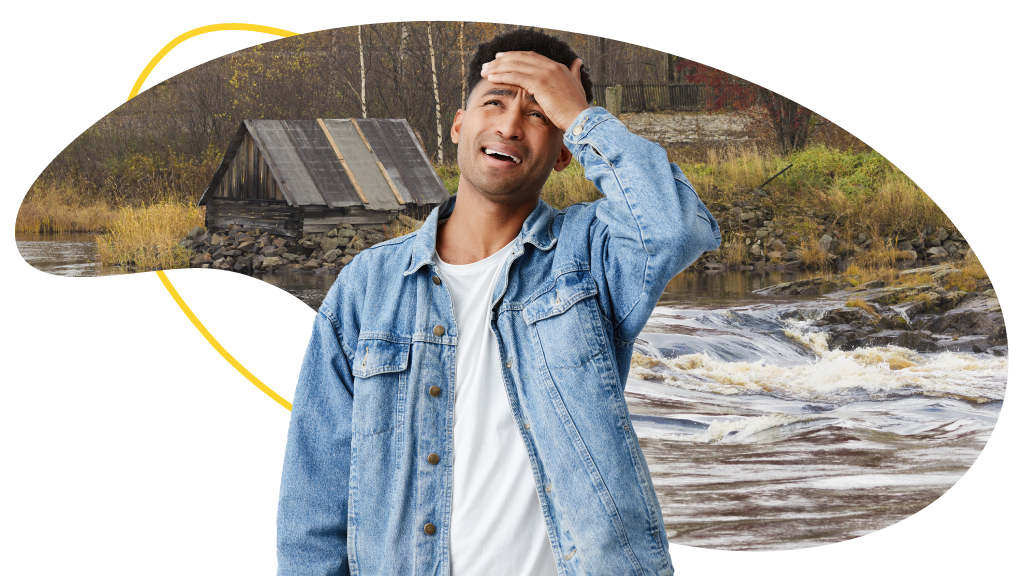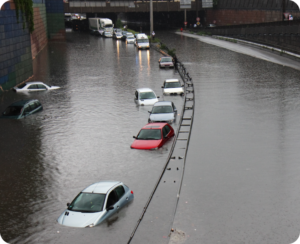There is no doubt that floods are becoming more common, with increasingly more dangerous conditions and costly damage. In addition, flash floods, which are floods caused by very heavy rains flooding cities in a very short amount of time, have also become more frequent, making preparation and prior knowledge even more decisive for your safety.
Knowing what to do before the waters rise, during the flood, and after it’s all over is key to ensuring your home and family are safe. If you live in a mapped flood zone, or in what has been identified as a risk area, take notes! You don’t want to forget the following recommendations:
Know the alerts
It’s important to understand the difference between watch and warning so you know what to do to stay safe.
Flood Watch or Flash Flood Watches
This means that there is a possibility of flooding or flash flooding in your area. Keep an eye out for changing weather conditions and possible flooding, and be prepared to move to higher ground.
Flood Warning
This means that floods are occurring or about to occur. Avoid low areas and, if necessary, evacuate.
Flash Flood Warning
This means a flash flood is occurring or about to occur. Look for higher ground immediately.
How to Prepare for a Flood
The preparation must be done even before any warning from the authorities. Planning, organizing and sharing these plans among the family can be the difference between survival and tragedy.
1. Create an emergency plan
In case you need to evacuate, you need to know where you will be going and how to get there. Your emergency plan should address the issues that may arise if you are forced to evacuate, as well as how and where your family will meet if you are not already together.
This plan must be shared among the residents of your house and you can even choose someone who lives in another region to be the main point of contact for everyone.
2. Prepare your house
There are several actions to prepare your home for possible flooding.
1. Discover your floodplain and flood risk.
2. If possible, transfer anything that is sensitive to water above the BFE.
3. Elevate your home.
3. Update your backflow valves and maintain your plumbing and sewer system.
4. Keep up to date with house maintenance, such as cleaning gutters, repairing the roof, sealing doors and windows, and so on.
5. Install a sump pump and test it regularly.
6. Turn off electricity when flooding is likely.
7. Use landscaping to divert your home’s water through terrain elevations.
8. Contact local authorities to inform them about small areas of flooding.
9. Look for physical barriers against flooding such as sandbags and protection for lower windows.
You can find more information in our article on minimizing the risk of flood damage to your home.
3. Assemble an emergency kit
Have an emergency kit for extreme situations, in case you need to leave your home, evacuate the region or even leave the city. The kit has to be visible and accessible so that you can get it quickly.
A basic kit must have:
- Ready-to-eat non-perishable foods
- Water
- A battery powered radio communicator
- A flashlight
- Extra batteries
- First aid kit
- Personal Medications
- Emergency blanket
- Whistle
- Toothbrush, toothpaste and other personal care products
- Exchanged money
- Copying important documents
- N95 masks
- Your emergency plan
- A change of clothes
You can add other items you consider an emergency, like a toy for your child or a power bank for your cell phone, just make sure everything has its place and is easy to transport.
4. Get Flood Insurance
Standard homeowners insurance policies do not cover flood damage, so it is important to be aware of the type of coverage you have. In some cases you are able to include flood insurance in your original policy, in others it is necessary to take out separately.
Therefore, review your policy and ensure that your home is protected from all risks applicable to you. The damage from a flood is much higher than any flood insurance fee, so talk to Breezy Seguros and we will find the best insurance for you.
If you have time, make a record of your home and belongings, taking photos or videos. Store these records in a safe place.
How to stay safe during a flood
Communication systems and emergency alerts are becoming more and more reliable, so you will probably know in advance that something is coming. However, the time between the alert and the arrival of the flood can be short, which means that all actions must be fast and efficient.
1. Protect your house
If the authorities issue a flood warning, you can start guarding your home with barriers. Place sandbags where water can enter, such as doors (especially sliding glass doors) and garages.
Move your belongings to higher floors, or countertops and shelves if you only have one floor. If you have furniture in the outdoor area, try to bring it inside, to avoid being washed away by the flood.
2. Protect your family
The most important thing here is to stay informed by listening to weather alerts in the news and locating your emergency kit so you are prepared to evacuate. If you receive an evacuation order, turn off the gas and electricity, grab your emergency kit and leave the house immediately.
Follow the authorities’ instructions when evacuating and do your best to:
- Not walk, swim or drive in floods.
- Avoid fast-moving bridges over water.
- Don’t stay in your car, only go up on the roof if the water is rising rapidly inside it.
- Even if you haven’t been ordered to evacuate, pay attention to water sources around you, such as streams that can overflow with little warning.
- If there is already water in your home, avoid touching electrical equipment as you can get shocked.
- Listen to the National Oceanic and Atmospheric Administration (NOAA) Weather Radio or local news stations to stay informed.
What to do after a flood
Even with the flood receding, you and your family can still be at risk.
Keep away from puddles of water or mud; the water can be contaminated by sewage, oil or fuel from cars and even bacteria, in addition, you may not see the bottom and the hole may be bigger than you think, or contain objects that can hurt someone.
Floods, even shallow ones, can drag you, so be careful. If you need to get around, be careful and avoid crossing large puddles of water, flooded avenues and bridges. Many structures may be at risk of collapsing due to the floods and the weight of a car may be all that is needed.
Emergency authorities recommend staying out of buildings and houses surrounded by water because they can be dangerous. You don’t know what the water did to the foundation and the building could collapse. It’s best to wait until the water goes down before re-entering.
Whatever you do, continue to listen for emergency alerts in case there are more floods on the way. Do not return to your home until the authorities say it is safe to do so.
Cleaning up after the flood
Wait for the water to go down before entering the house again. As soon as you can, safely wear wellies, waterproof gloves and an N95 mask to protect yourself. Don’t forget to make sure the electricity is off and refrain from touching appliances if they are wet or in water.
Other important steps:
- Check for gas or water leaks to resolve before returning home.
- Dry your home: Your goal is to dry your home within 24 hours to prevent mold and limit damage to walls, floors, and foundations. You can hire an expert to pump water.
- Disinfect your belongings: Remember that the water is probably contaminated, so sanitize the affected items you intend to keep.
- Flooded floors and walls should be washed with a solution of two caps of household bleach for every gallon of water.
- Carpets, mattresses and upholstered furniture must be discarded or disinfected by a professional cleaner.
- Remove and replace any drywall or panel that has been left underwater. Use a moisture meter to make sure the wood pegs and frame are dry before replacing the drywall. Fungal growth in hidden places is a significant health hazard.
This is also a good time to take pictures of the damage and contact your insurer to begin the claim process. They will send an insurance adjuster to assess your claim, but be patient as there may be many people who need help.
Climate change, rising sea levels and massive constructions that are waterproofing the soil of large cities have brought more and more floods, which in turn are becoming faster and more violent. Preparing for this tragedy can be what keeps your family and home safe, so be sure to stay prepared and alert at all times.








